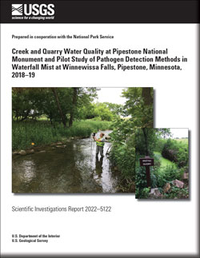Creek and Quarry Water Quality at Pipestone National Monument and Pilot Study of Pathogen Detection Methods in Waterfall Mist at Winnewissa Falls, Pipestone, Minnesota, 2018–19
Links
- Document: Report (6.37 MB pdf) , HTML , XML
- Dataset: USGS National Water Information System database —USGS water data for the Nation
- Data Release: USGS data release - Algal toxins and Mycobacterium avium ssp. paratuberculosis measured in surface-water, quarry-water, and sediment samples collected at Pipestone National Monument, Pipestone, Minnesota, 2018–19
- Download citation as: RIS | Dublin Core
Abstract
Pipestone National Monument is a 301-acre site sacred to many Native American Tribes, providing cultural exhibits and walking trails to Pipestone Creek, Winnewissa Falls, and historical pipestone quarries for numerous visitors each year. However, the Minnesota Pollution Control Agency has determined turbidity and fecal coliform bacteria occur in Pipestone Creek in high enough numbers to be a potential health hazard. Concerns also were raised about exposure risk from waterfall mist to visitors and staff. The U.S. Geological Survey and the National Park Service collaborated on a study to collect 21 water-quality samples from 8 creek sites and 3 quarries in 2018 and analyzed them for over 250 water-quality parameters and contaminants. Additional samples were collected in August 2019 to assess the waterfall mists from Winnewissa Falls. Nutrient concentrations in the creek and quarries were elevated in 2018, indicating they are affected by agricultural inputs. All sample concentrations for nitrate and total nitrogen in Pipestone Creek exceeded Minnesota standards and U.S. Environmental Protection Agency nutrient criteria. Minnesota standards and U.S. Environmental Protection Agency nutrient criteria for total phosphorus also were exceeded in some of the quarry samples. Twenty of 210 micropollutants had measurable concentrations: 13 pesticides, 5 pharmaceuticals, and 2 other types of micropollutants. Atrazine, deethylatrazine, and metolachlor ethanesulfonic acid were detected in all 21 samples collected during the study. The five pharmaceuticals detected were acetaminophen, gabapentin, gemfibrozil, metformin, and oxycodone. Gabapentin (10 of 21 samples) and metformin (8 of 21 samples) were the most commonly detected pharmaceuticals. None of the detected micropollutant concentrations exceeded any Minnesota standards or U.S. Environmental Protection Agency aquatic life benchmarks, except the acute toxicity benchmark for nonvascular plants for atrazine. Two cyanotoxins, anatoxin-a and microcystin, were detected, but concentrations were below U.S. Environmental Protection Agency guidelines for swimming or recreation. Notably, total coliform, fecal coliform, and Escherichia coli were detected in all creek samples, and concentrations generally decreased downstream, suggesting contamination potentially occurred upstream from the monument. Mycobacterium avium ssp. paratuberculosis was not detected in any creek sediment samples but was detected in three water samples from the creek. Three organisms were detected in the 2019 water and mist sampling from Winnewissa Falls. Two of these organisms can cause illness in humans (Cryptosporidium and Legionella), and a third (ruminant Bacteroides) is an indicator of manure contamination. Despite few samples, pathogen-positive water samples and air sampling demonstrated the feasibility and utility of the mist sampling approach outlined in this report.
Suggested Citation
Krall, A.L., King, K.A., Christensen, V.G., Stokdyk, J.P., Scudder Eikenberry, B.C., and Stevenson, S.A., 2023, Creek and quarry water quality at Pipestone National Monument and pilot study of pathogen detection methods in waterfall mist at Winnewissa Falls, Pipestone, Minnesota, 2018–19: U.S. Geological Survey Scientific Investigations Report 2022–5122, 80 p., https://doi.org/10.3133/sir20225122.
ISSN: 2328-0328 (online)
Study Area
Table of Contents
- Acknowledgments
- Abstract
- Introduction
- Methods
- Characterization of Creek and Quarry Water Quality
- Pilot Study of Pathogen Detection Methods in Waterfall Mist at Winnewissa Falls
- Summary
- References Cited
- Appendix 1. Supplementary Data Tables
| Publication type | Report |
|---|---|
| Publication Subtype | USGS Numbered Series |
| Title | Creek and quarry water quality at Pipestone National Monument and pilot study of pathogen detection methods in waterfall mist at Winnewissa Falls, Pipestone, Minnesota, 2018–19 |
| Series title | Scientific Investigations Report |
| Series number | 2022-5122 |
| DOI | 10.3133/sir20225122 |
| Publication Date | February 01, 2023 |
| Year Published | 2023 |
| Language | English |
| Publisher | U.S. Geological Survey |
| Publisher location | Reston, VA |
| Contributing office(s) | Minnesota Water Science Center, Upper Midwest Water Science Center |
| Description | Report: ix, 80 p.; Data Release; Dataset |
| Country | United States |
| State | Minnesota |
| City | Pipestone |
| Other Geospatial | Winnewissa Fall |
| Online Only (Y/N) | Y |


